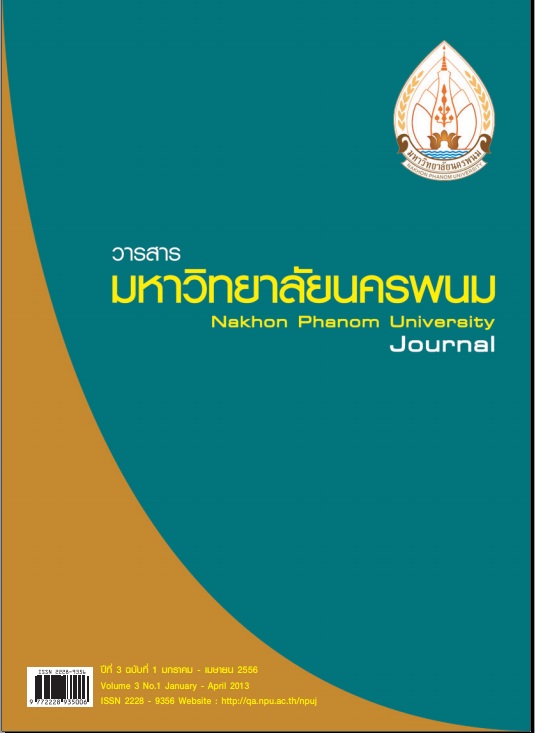เปรียบเทียบผลสัมฤทธิ์ทางการเขียนเชิงสร้างสรรค์ กลุ่มสาระการเรียนรู้ภาษาไทยของนักเรียนชั้นประถมศึกษาปีที่ 6 ที่ได้รับการจัดการเรียนรู้แบบวัฏจักรการเรียนรู้(4 MAT) กับการจัดการเรียนรู้เชิงสร้างสรรค์ของฟูเนอร์ (Furner)
Main Article Content
Abstract
การวิจัยครั้งนี้มีวัตถุประสงค์เพื่อ 1) เปรียบเทียบผลสัมฤทธิ์ทางการเรียนระหว่างกลุ่มที่ได้รับการเรียนรู้แบบวัฏจักรการเรียนรู้ และเรียนรู้แบบเชิงสร้างสรรค์ของฟูเนอร์ และ 2) ศึกษาความพึงพอใจต่อการเรียนรู้แบบวัฏจักรการเรียนรู้ และเรียนรู้แบบเชิง สร้างสรรค์ของฟูเนอร์ ประชากร ได้แก่ นักเรียนชั้นประถมศึกษาปีที่ 6 ภาคเรียนที่ 1 ปีการศึกษา 2554 ในสังกัด กลุ่มโรงเรียนเครือข่าย ขยายโอกาสท่าอุเทน สำนักงานเขตพื้นที่การศึกษาประถมศึกษานครพนม เขต 2 ทั้งหมด 7 โรง จำนวน 9 ห้อง รวมทั้งหมด 216 คน กลุ่มตัวอย่างที่ใช้ในการวิจัย ได้แก่ นักเรียนชั้นประถมศึกษาปีที่ 6 ภาคเรียนที่ 1 ปีการศึกษา 2554 โรงเรียนบ้านห้วยพระ อำเภอท่าอุเทน สำนักงานเขตพื้นที่การศึกษาประถมศึกษานครพนม เขต 2 จำนวน 41 คน จาก 2 ห้อง ซึ่งได้มาโดยการเลือกแบบ เจาะจง แล้วสุ่มอย่างง่ายโดยการจับสลากเพื่อสุ่มห้องสำหรับใช้ทดลองเป็นกลุ่มทดลองที่ 1 จำนวน 20 คน จัดการเรียนรู้แบบวัฏจักร การเรียนรู้ และกลุ่มทดลองที่ 2 จำนวน 21 คน จัดการเรียนรู้แบบเชิงสร้างสรรค์ของฟูเนอร์ เครื่องมือที่ใช้ในการวิจัย ได้แก่ แบบทดสอบ วัดผลสัมฤทธิ์ทางการเขียนเชิงสร้างสรรค์ เป็นแบบทดสอบอัตนัยเพื่อวัดทักษะความคิดสร้างสรรค์ทางภาษาและการเขียนเรื่อง จำนวน 6 ข้อ 80 คะแนน มีค่าอำนาจจำแนกตั้งแต่ 0.45 ถึง 0.55 และค่าความเชื่อมั่นทั้งฉบับเท่ากับ 0.84 และแบบวัดความพึงพอใจ จำนวน 15 ข้อ มีค่าอำนาจจำแนกตั้งแต่ 0.36 ถึง 0.68 และ 0.34 ถึง 0.61 มีค่าความเชื่อมั่นทั้งฉบับเท่ากับ 0.85 และ 0.79 ตามลำดับ สถิติที่ใช้ในการวิเคราะห์ข้อมูล ได้แก่ ค่าเฉลี่ย ส่วนเบี่ยงเบนมาตรฐาน และการทดสอบสมมติฐานโดยใช้ t-test (Independent Samples) ผลการวิจัย พบว่า 1) นักเรียนชั้นประถมศึกษาปีที่ 6 ที่เรียนรู้แบบวัฏจักรการเรียนรู้ มีผลสัมฤทธิ์ทางการเรียนสูงกว่า นักเรียนที่เรียนรู้แบบเชิงสร้างสรรค์ของฟูเนอร์ อย่างมีนัยสำคัญทางสถิติที่ระดับ .05 2) นักเรียนที่เรียนด้วยการจัดกิจกรรมการเรียนรู้ แบบวัฏจักรการเรียนรู้ และที่เรียนรู้แบบเชิงสร้างสรรค์ของฟูเนอร์ ต่างมีความพึงพอใจต่อวิธีการสอนที่ได้รับอยู่ในระดับมาก
The purpose of the research were to : 1) Compare learning achievement between two groups of students who learned with Cycle Technique Learning Approach and Furner Creative Learning Approach and 2) Study the satisfaction towards learning by using Cycle Technique Learning Approach and Furner Creative Learning Approach.
The sample consisted of 41 students of Prathomsuksa 6, Banhuaipra school under Nakhon Phanom Primary Educational Service area Office 2, the 1st semester, academic year 2011, selected by the purposive sampling technique, defined as 20 students for the using Cycle Technique LearningmApproach was the first experiment group and 21 students for the Furner Creative Learning Approach was the second experiment group. The 4 types of instrument used in the research were; 1) Cycle Technique Learning Approach, 2) Furner Creative Learning Approach, 3) The instruments for collecting data were the learning achievement of Thai Language test capabilities entitled “Creative Writing Achievement Tests” with the discrimination power between 0.45-0.55 and the total reliability of 0.84. and, 4) 15-item, 5 rating scale of the satisfaction’s test towards Thai Language learning towards Cycle Technique Learning Approach and Furner Creative Learning Approach with item discrimination between 0.36-0.68 and 0.34-0.61 respectively, the α – Coefficient were at 0.85 and 0.79 respectively. Statistics use analyze data were means, percentage, standard deviation and learning effectiveness index which employed for hypothesis testing. The results were as follows: 1) The achievement on “Writing Achievement” for Prathomsuksa 6 students learned with Cycle Technique Learning Approach and Furner Creative Learning Approach was different The students who learning with Cycle Technique Learning Approach had higher achievement than the students who learnก with Furner Creative Learning Approach with the statistical significance level of .05. 2) The satisfaction towards learning activity entitled “Writing Achievement” for Prathomsuksa 6 students by using Cycle Technique Learning Approach and Furner Creative Learning Approach were at the high level.


